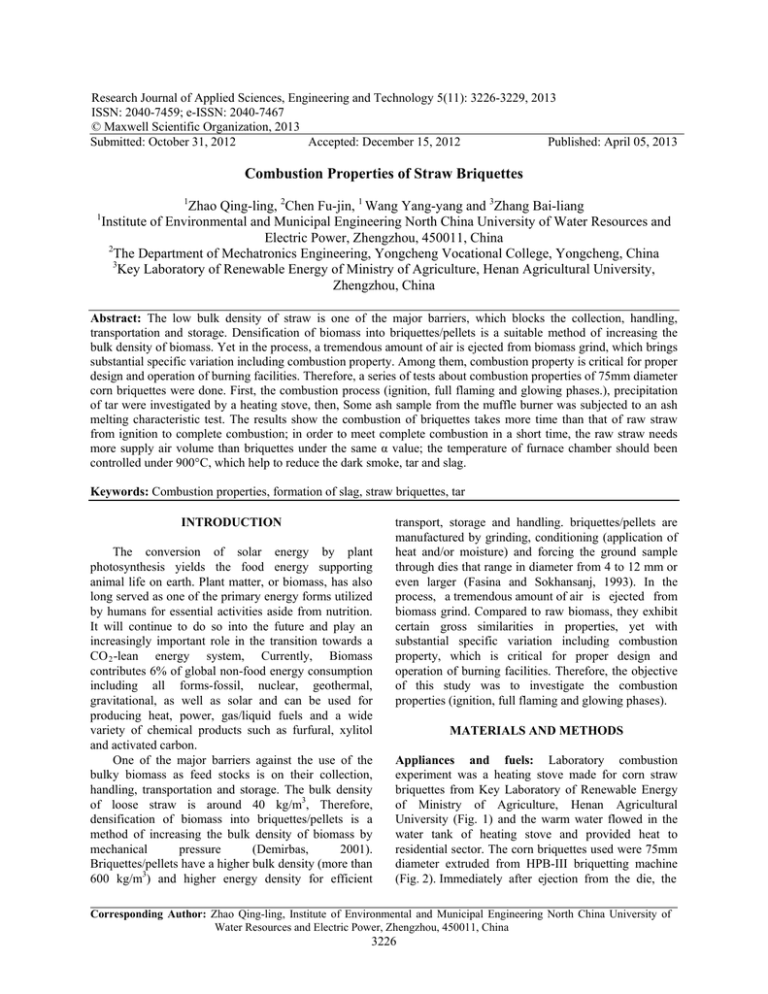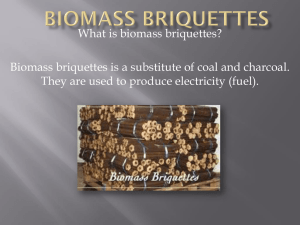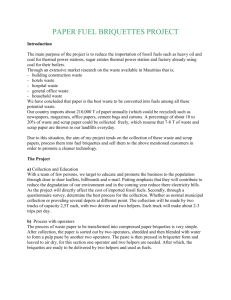Research Journal of Applied Sciences, Engineering and Technology 5(11): 3226-3229,... ISSN: 2040-7459; e-ISSN: 2040-7467
advertisement

Research Journal of Applied Sciences, Engineering and Technology 5(11): 3226-3229, 2013 ISSN: 2040-7459; e-ISSN: 2040-7467 © Maxwell Scientific Organization, 2013 Submitted: October 31, 2012 Accepted: December 15, 2012 Published: April 05, 2013 Combustion Properties of Straw Briquettes 1 Zhao Qing-ling, 2Chen Fu-jin, 1 Wang Yang-yang and 3Zhang Bai-liang Institute of Environmental and Municipal Engineering North China University of Water Resources and Electric Power, Zhengzhou, 450011, China 2 The Department of Mechatronics Engineering, Yongcheng Vocational College, Yongcheng, China 3 Key Laboratory of Renewable Energy of Ministry of Agriculture, Henan Agricultural University, Zhengzhou, China 1 Abstract: The low bulk density of straw is one of the major barriers, which blocks the collection, handling, transportation and storage. Densification of biomass into briquettes/pellets is a suitable method of increasing the bulk density of biomass. Yet in the process, a tremendous amount of air is ejected from biomass grind, which brings substantial specific variation including combustion property. Among them, combustion property is critical for proper design and operation of burning facilities. Therefore, a series of tests about combustion properties of 75mm diameter corn briquettes were done. First, the combustion process (ignition, full flaming and glowing phases.), precipitation of tar were investigated by a heating stove, then, Some ash sample from the muffle burner was subjected to an ash melting characteristic test. The results show the combustion of briquettes takes more time than that of raw straw from ignition to complete combustion; in order to meet complete combustion in a short time, the raw straw needs more supply air volume than briquettes under the same α value; the temperature of furnace chamber should been controlled under 900°C, which help to reduce the dark smoke, tar and slag. Keywords: Combustion properties, formation of slag, straw briquettes, tar INTRODUCTION The conversion of solar energy by plant photosynthesis yields the food energy supporting animal life on earth. Plant matter, or biomass, has also long served as one of the primary energy forms utilized by humans for essential activities aside from nutrition. It will continue to do so into the future and play an increasingly important role in the transition towards a CO 2 -lean energy system, Currently, Biomass contributes 6% of global non-food energy consumption including all forms-fossil, nuclear, geothermal, gravitational, as well as solar and can be used for producing heat, power, gas/liquid fuels and a wide variety of chemical products such as furfural, xylitol and activated carbon. One of the major barriers against the use of the bulky biomass as feed stocks is on their collection, handling, transportation and storage. The bulk density of loose straw is around 40 kg/m3, Therefore, densification of biomass into briquettes/pellets is a method of increasing the bulk density of biomass by mechanical pressure (Demirbas, 2001). Briquettes/pellets have a higher bulk density (more than 600 kg/m3) and higher energy density for efficient transport, storage and handling. briquettes/pellets are manufactured by grinding, conditioning (application of heat and/or moisture) and forcing the ground sample through dies that range in diameter from 4 to 12 mm or even larger (Fasina and Sokhansanj, 1993). In the process, a tremendous amount of air is ejected from biomass grind. Compared to raw biomass, they exhibit certain gross similarities in properties, yet with substantial specific variation including combustion property, which is critical for proper design and operation of burning facilities. Therefore, the objective of this study was to investigate the combustion properties (ignition, full flaming and glowing phases). MATERIALS AND METHODS Appliances and fuels: Laboratory combustion experiment was a heating stove made for corn straw briquettes from Key Laboratory of Renewable Energy of Ministry of Agriculture, Henan Agricultural University (Fig. 1) and the warm water flowed in the water tank of heating stove and provided heat to residential sector. The corn briquettes used were 75mm diameter extruded from HPB-III briquetting machine (Fig. 2). Immediately after ejection from the die, the Corresponding Author: Zhao Qing-ling, Institute of Environmental and Municipal Engineering North China University of Water Resources and Electric Power, Zhengzhou, 450011, China 3226 Res. J. Appl. Sci. Eng. Technol., 5(11): 3226-3229, 2013 precipitation of tar were recorded. The replications of test were done and the results were contrast, the final result averaged. Combustion process: The combustion process can be divided into four phases: ignition, full flaming, glowing and burnout phases. The ignition is from the beginning reaction of fuel and oxygen to the temperature before intense combustion. The ignition conditions of briquettes are Fig. 1: Heating stove the same to other fuels: the volatile materials released from briquettes, the appropriate atmosphere amount and ignition temperature. Yet there is some specific variation which was caused by the structure of briquettes. The corn straw briquettes exist as individual pieces with similar shapes and sizes. The bulk density of whole corn straw briquettes is higher than the density of raw corn straw (i.e., 0.13-0.23g/cm3), so the release rates of volatile materials and the rates of heat transfer are both slow, which limit the kinetic rates of reaction. Fig. 2: Corn straw briquettes extruded from HPB-III briquetting As a result, the ignition time of corn straw briquettes is machine little longer than that of raw corn straw (i.e., about 2-3 min), but far shorter than that of coal. In the ignition phase, the diameter and length of corn straw briquettes also affect the ignition time, the size is less, the time is shorter, but they are not dominant factors. It is observed that when the temperature is up to 300-400°C, which is higher than that of raw corn straw (i.e. 190~210°C), there is a very rapid loss of weight due to the evolution of volatile material, which in an oxidative environment (e.g., Air) will ignite and burn (Fig. 3a). (a) (b) After ignition, the combustion enters into full flaming and glowing phases. In this phase, two predominant factors are the rates of heat transfer and the kinetic rates of reaction. Briquette size and density together dominates the influence of heat transfer, with big, higher density briquettes heating more slowly and small, lower density briquettes or raw straw heating rapidly. In the beginning of the phase, it is mainly volatile materials burning, which produces thin red and slightly (c) (d) orange flame and lasts 10 min. The burning of volatiles is generally quite rapid and follows as fast as volatiles Fig. 3: The combustion process of corn straw briquettes, (a) are released. With temperature rising, the outer char of Ignition, (b) Diffusion combustion, (c) Smooth briquettes starts to burn with little amount volatile combustion, (d) Ashes released from the inner of briquettes, the flame becomes thick orange and the burning is slow and briquettes were transferred to zip-lock plastic bags and violence. From loss of weight, the curve declines stored for 3 weeks at room temperature (about 25°C). slowly. After three weeks of storage, the diameter of the With the red flame gradually fading out, the blue briquettes ranged from 78.0 to 88 mm, Unit density, and orange flame is increasing and the blue flame durability and moisture content of the briquettes were envelops the orange flame little by little (Fig. 3b). respectively 0.8-1.2 g/cm3, 95% and 10-15% (w/b.). Burning away, the blue flame becomes little and Every time, there were about 1.0-1.5 kg corn short and gradually turns red, at the same time, the briquettes added into heating stove, the ignition, full burning is stronger and more violence (Fig. 3c), which flaming, glowing phases and banking the fire were is mainly char materials burning. observed, temperature changes, formation of slag and 3227 Res. J. Appl. Sci. Eng. Technol., 5(11): 3226-3229, 2013 The residual char keeps on burning until burns out and becomes a ash ball. From the outer of ash ball, it is dark red and no flame is found (Fig. 3d), the combustion ends. According to the fuel, the burning course can be also divided into two phases: the burning of gas phase (i.e., Volatile materials released through pyrolysis of the fuel upon heating) and the burning of solid phase (i.e., the solid phase as char oxidation). The briquettes took around 50 min for complete combustion which is far longer than the raw straw. During combustion the outer briquettes didn’t crumbled and maintained their original shape. Diameter of charcoal was found around 50-55 mm. Its strength was loose and not as good as wood charcoal. Table 1: The ash melting characteristic temperatures of corn briquette °C Category DT ST HT FT t 1140 1180 1230 1280 RESULTS AND DISCUSSION Fig. 4: Variation of temperature with time 14 12 Slagging rate Variation of temperatures with time: The rate of combustion is very important in the design of combustion systems, which affects the supply air volume and excess air coefficient (i.e.,α). Taking the raw corn straw, the corn straw briquettes and pine wood (the length, width and height is respective 20.0, 20.0 and 20.0 mm), respectively as the sample, the samples were observed to dry (if the sample contains moisture which is normally the case, biomass being hygroscopic and extreme care needed in handling to achieve a bone dry sample in the TGA), then were transferred to ziplock plastic bags. Taking 2 kg sample from every fuel into three muffle burners respectively, the variation of temperatures with time of each sample in the combustion is shown in Fig. 4. In the Figure, these curves were mainly predominated by the density of fuel. Due to the low density of raw straw, which is in an oxidative environment (e.g., air), the temperature of ignition is low, about 210ºC; after ignition, the volatiles are released fast and the burning is generally quite rapid, with that, the residual charcoal burns out, from ignition to complete combustion, the time is very short and the temperature changes fast with time, however, the curves formed by the combustion of briquettes and wood are increasing smoothly, which is caused by the combustion of volatiles. Then, when it enters solid phase (char oxidation), the rise rate of temperature reduce which is caused by the higher density of fuel. The time from ignition to complete combustion lasts longer (50 min and 70 min). When under the same α value the raw straw needs more supply air volume than briquettes and wood to meet complete combustion in a short time. 10 8 6 4 2 0 400 600 800 T/C 1000 1200 Fig. 5: The relationship between temperature and slag rate previously been more thoroughly described (Yuan and Rong-Sheng, 2006) and only a brief description is given here. First, ash sample is made into triangle cone, then its shape change is observed under deoxidize gas and heat until four melting temperatures are achieved which are Distortion Temperature (DT), soft temperature (ST), Hemisphere Temperature (HT) and Flow Temperature (FT). The results from the experiments are shown in Table 1. Usually, the method of ash melting characteristic temperatures is a kind of Rough estimation. The actual onset of slag was mainly determined by the temperature of furnace chamber. The change relationship between temperature and slag rate is shown in Fig. 5. In the figure, under 650°C, the slag rate goes near to zero. From 650°C to 850°C, the slag rate rises linearly. Thereafter, it stays stably at about 11% with the temperature improving until 960°C. Above 960°C, the slag rate rises with the temperature improving again. Formation of slag: Some ash sample from the muffle Considering the running safety of burner and the slag burner was subjected to an ash melting characteristic rate, the temperature should be controlled at test. The method of ash melting characteristic test has 900°C. 3228 Res. J. Appl. Sci. Eng. Technol., 5(11): 3226-3229, 2013 Precipitation of Tar: Tar is a problem in the biomass gasification, which often jams and erodes the pipes. Usually, the peak output of tar is at about 500°C. From ignition to the beginning of full flaming, a little dark smoke and tar were observed. Then they faded away, when the temperature was 734-78°C, they disappeared, which showed that the combustion was complete and the tar burned out, at this moment. So improving the temperature of ignition, shortening the process from ignition to the beginning of full flaming and increasing combustion air are help to reduce the dark smoke and tar. CONCLUSION Compared with the raw straw, from ignition to complete combustion the straw briquettes takes more time; under the same α value the raw straw needs more supply air volume than briquettes to meet complete combustion in a short time. According to the relationship of the slag rate and the temperature of furnace chamber and the running safety of burner, the temperature of furnace chamber should be controlled at 900°C, which also help to reduce the dark smoke and tar. ACKNOWLEDGMENT The author gratefully acknowledge Key laboratory of renewable energy of Ministry of Agriculture, Henan Agricultural University, whose appliances and fuels have made the research possible and we are also greatly thankful to the financial supports from the Science and Technology Foundation of the Education Department of Henna Province, China (2009B480006). REFERENCES Demirbas, A., 2001. Biomass resource facilities and biomass conversion processing for fuels and chemicals. Energ. Convers. Manag., 42: 1357-1378. Fasina, O.O. and S. Sokhansanj, 1993. Equilibrium moisture relations and heat of sorption of alfalfa pellets. J. Agric. Eng. Res., 56: 51-63. Yuan, L. and L. Rong-Sheng, 2006. Study on combustion characteristics of biomass. Energ. Eng., 4: 30-33. 3229








